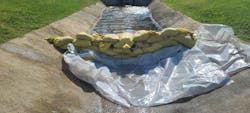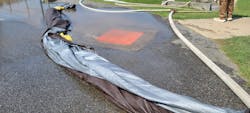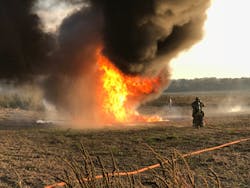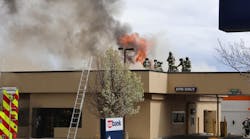Product control is an essential aspect of a hazmat response, and it goes beyond the common application of absorbents to soak up vehicle fluids after a wreck. NFPA 470: Hazardous Materials/Weapons of Mass Destruction (WMD) Standard for Responders defines control in relation to hazmat as “the procedures, techniques, and methods used in the mitigation of hazardous materials/weapons of mass destruction (WMD) incidents, including containment, extinguishment, and confinement.” When we think of a hazmat response, our mind often might jump to technicians who are suited up in a Level A hazmat suit and moving into a Hot Zone to plug or patch a leaking container or perform some type of involved repair. Although this does happen and is product control, the reality is that the vast majority of hazmat incidents are mitigated successfully with much simpler procedures. Even in complex incidents, the basics of product control still often must be performed.
Confinement
NFPA 470 defines confinement as “those procedures taken to keep a material, once released, in a defined or local area.” The procedures available to us include absorption/adsorption, damming/diking/diversion/retention, dilution, and vapor dispersion/vapor suppression The terms absorption and adsorption often are used interchangeably. Although the two processes are similar, they are different and can get very complicated scientifically.
For simplicity’s sake, it’s worthwhile to think of absorption as when a product soaks into a sponge or paper towel. When a product absorbs into such an absorbent medium, that medium expands. Absorbents can hold a significant volume of product by weight because of this expansion of the medium.
Conversely, adsorption occurs at a molecular level, where the molecules of the product adhere to the surface molecules of an adsorbent medium. Very little, if any, expansion of the medium occurs during this process, because the product adheres to the available surface area. For example, when sand is placed on a product for confinement, the product doesn’t soak into the grains of sand. The product adheres to the surface area of the sand grains. In the case of a porous adsorbent, such as activated charcoal, the product still adheres to the surface area of the charcoal. This surface area is increased because of the presence of pores.
Although there can be confusion and even intelligent debate regarding a medium’s status as an absorbent or adsorbent, the more important concept to understand is the different types of sorbent materials and how they can best mitigate your situation.
Sorbents
Sorbent materials work great at confining small spills and can be used in conjunction with other confinement techniques. Sorbent materials can come in the form of loose materials, such as cellulose, clay, peat moss, sand, vermiculite, and even loose sorbents that are specific to oils or corrosives. They are simple to deploy. Other than some of the lighter weight materials that are affected by wind and the necessity to get close to product to deploy, they don’t have a lot of negative aspects.
Other common sorbent options are booms, pads, pillows and socks. These sorbent materials typically come in three types: corrosive materials (sometimes called hazmat), hydrophobic (sometimes called oil-only) and universal.
There is no industry standard for color-coding these sorbent materials, because different manufacturers use different colors. Because of this, it’s important to ensure the compatibility of the material with the product that you attempt to confine. Using a pike pole or roof hook, these materials can be maneuvered and placed in the location where they are needed most to keep the responders at a safe distance, to lower the risk of contamination to those individuals.
Damming
The processes of damming, diking, diversion and retention can be very beneficial confinement techniques depending on the situation that’s encountered.
There are three types of dams for product confinement: static, underflow and overflow.
Static dams hold back all liquid to include product and any water that might be present in the waterway where the dam is being positioned. The ideal uses of static dams
are for products that are miscible in water and in dry waterways where only the hazardous materials product is of concern.
The configuration of underflow dams allows water to flow through at their bottom while they allow a product that floats on water to be collected at their top. Booms and socks can be paired with this type of dam to collect product at the top of the dam.
The configuration of overflow dams allows water to pass through at their top while they collect a product that’s heavier than water at their bottom.
The construction of these three types of dams might vary based on location, personnel and equipment.
Don’t forget that pipes are needed to allow waterflow in the underflow and overflow dams.
Sandbags are convenient when they are prefilled and can be brought to a location quickly, but most don’t live in that world. A more realistic approach is that several firefighters will be put to work on a shovel.
Diking, diversion & retention
Diking, diversion and retention use the same skills as damming necessitates but usually on a smaller scale.
Dikes often are built around areas that are desired to be protected from a released product—for example, a storm drain. In a perfect world, if a hazmat-intended storm drain cover is backed up with a dike around the drain, it’s a good day.
Sometimes, we must settle for just building a dike around the storm drain or placing a tarp/salvage cover over the drain and then place sand or soil on top of the tarp.
Diversions are just as the name suggests: They divert the product away from an area that’s desired to be protected or to an area where it’s desired to go, such as a retention that responders built out of available materials, a natural one, if available, or a combination of the two. Diversions can be made from soil, sandbags, charged hoselines, a combination of those, and natural channels based on topography and location.
Dilution & vapor dispersion
Dilution generally is considered a tactic of last resort or that’s done under particular circumstances. It can be effective on products that are miscible in water, such as corrosives, peroxides and polar solvents, to bring high concentrations to a safe or less hazardous level. Many variables must be known to perform this tactic safely and to avoid a larger problem.
Much of the same is true when it comes to vapor dispersion. This tactic uses a fog nozzle to move vapors from an undesired area, much like with hydraulic ventilation of smoke in firefighting. Some vapors mix with water to form new compounds, such as how anhydrous ammonia gas and water produce liquid ammonium hydroxide. That new product must be dealt with in the form of runoff.
That said, vapor dispersion can be a valid tactic to protect members when they perform a line-of-sight rescue or to direct a flammable gas or vapor away from a potential ignition source until the source can be secured.
Extinguishment
NFPA 470 defines extinguishment in terms that all firefighters can relate to: “to cause to cease burning.” That said, it’s difficult to confine or contain a product when an active fire is present.
Extinguishment might be necessary to eliminate fire impingement and heat
stress that’s on a product’s container or
to clear a safe area to perform other control techniques. This could be as simple as a passenger vehicle fire or propane cylinder that’s near to a burning structure. It can be as complex as a well-involved fixed facility or large train derailment.
There might be times when extinguishment isn’t possible or isn’t the best course of action—for example, a rolled over DOT-406 tank trailer that has thousands of gallons of flammable liquid on board. In this scenario, numerous factors, such as location, water supply, foam supply and available staffing, come into play. So, too, does the matter of what to do with the remaining liquid in the event that you’re successful in extinguishing such a large fire load.
Although it might be difficult for some firefighters to accept, sometimes nonintervention is the best course of action.
Containment
NFPA 470 defines confinement as “the actions taken to keep a material in its container (e.g., to stop a release of the material or reduce the amount being released).” For the operations-level responder, these options are limited to activation of emergency shutoffs that are found in fixed facilities and on cargo tanks; shutting off a valve on a container, provided that it can be accomplished while staying out of the product; and manipulation of a container, such as a drum, by rolling or uprighting, again provided that it can be done without contacting the product. Manipulation of valves and the movement of containers are tasks for which the pike pole or roof hook come in handy to avoid contamination.
Preparation
No approach to product control works in every scenario. It’s critical to regularly review department policies and procedures, practice the techniques that are within your department’s capabilities, and stay current with the latest trends, techniques and technologies to ensure successful incident mitigation.









